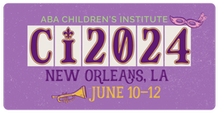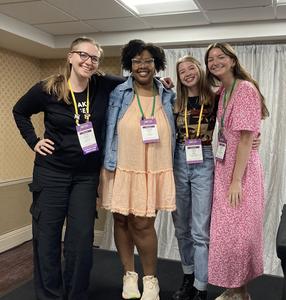 On Wednesday at Children's Institute, booksellers discussed "Social Emotional Learning with Romance," moderated by Danielle Pernell of King's Books in Tacoma, Wash., with panelists Sydney Wilson from Little Shop of Stories, Decatur, Ga., Haley Calvin of the Novel Neighbor, Webster Groves, Minn., and Nicole Brinkley from Oblong Books, Rhinebeck, N.Y. Romance is not only good for business, the panel said, but also good for young people exploring identity and emotions. As Pernell put it, "Romance is important because everyone deserves a love story."
On Wednesday at Children's Institute, booksellers discussed "Social Emotional Learning with Romance," moderated by Danielle Pernell of King's Books in Tacoma, Wash., with panelists Sydney Wilson from Little Shop of Stories, Decatur, Ga., Haley Calvin of the Novel Neighbor, Webster Groves, Minn., and Nicole Brinkley from Oblong Books, Rhinebeck, N.Y. Romance is not only good for business, the panel said, but also good for young people exploring identity and emotions. As Pernell put it, "Romance is important because everyone deserves a love story."
The panelists began by outlining a few specific notes: "Age categories are so important," Brinkley said, "Adult romance serves different needs than teen and YA romance. When publishers are conflating them in marketing, it's a problem." Pernell agreed. "Just because someone can read it doesn't mean they're emotionally ready to read it." The panelists agreed it is generally fine for teens to read adult romance with "knowledge and consent," but it is imperative booksellers and readers understand that the age categories should be kept separate.
The differences between "little R" romance and "big R" romance are also very important. "Big R romance is the genre," Wilson said. "It tends to lean adult; 'little R' romance is a topic, and it doesn't necessarily have to be romantic." "Little R" romance "explores all different kinds of romance," Calvin said. In "big R" romance, Brinkley added, the romance itself is the focus of the story, and a Happily Ever After is guaranteed, while "little R" romances can be side stories and subplots within larger narratives.
 |
|
| (l.-r.) Sydney Wilson, Haley Calvin, Nicole Brinkley, Danielle Pernell | |
"Sex" vs. "sexuality" was also a large part of the discussion: "Sex is an act. Sexuality is who you are and who you form romantic/platonic relationships with," Pernell said, "In romance, sexual exploration and expression is at the forefront, not sex." In adult romance, however, the "sex is often erotic and meant to titillate," Brinkley said. "In YA, it's to develop emotional connections." Just because there is sex in a YA book doesn't mean there is an emotional connection. This, Brinkley pointed out, "is the social and emotional learning element--it's not erotic, it's how we grow." Both Wilson and Calvin discussed their own youthful experiences with romance, Wilson recalling that "little R" YA and middle-grade romances "were instrumental in me exploring other sexualities and introducing me to people who don't express sexuality in the same way I do."
The slideshow presentation explained social emotional learning: "the process kids, young people, and adults go through to develop healthy relationships." Romance allows readers to identify with experiences outside of them that "resonate," and helps them "objectively analyze relationship dos and don'ts, and later apply what they learned to their own relationships." This can include exploring gender, identity, sexuality, boundaries, and giving and receiving consent.
The panelists included a slide showing general ages and the social emotional learning that can take place through reading romance: tweens (10-12) will be investigating social bonds; young teens (12-14) are given "an opportunity to explore and engage with different identities"; older teens (14+) can find "a safe space to explore boundaries" and learn about "giving and receiving consent." According to the panelists and their research, "reading romance has a neuropsychological impact by creating oxytocin. This encourages feelings of trust, connection, and bonding with others." So, Brinkley said, "giving kids escapist romance will make them better, healthier people chemically."
Wilson, Calvin, Brinkley, and Pernell included several actionable items for booksellers when it comes to romance and young readers. For example, many young readers are reading up by middle school--share romance that is "right" for the individual. If you're recommending a book, the panelists said, know the content. "If you don't read romance yourself," Calvin said, "have go-to authors" (a short list compiled by the panelists can be found here). "Take care of your teens who are looking to explore sex and sexuality," Calvin said. "Have comps from adult to YA to middle-grade. Learn how to redirect and make sure they are learning safely and being taken care of." And, if they are ready for "big R" romance, "put healthy relationships in their hands first."
The best way to know what you're talking about and sell it appropriately is, of course, to "read romance," Brinkley said. "The next best thing you can do is have someone on your staff who reads romance. But if you don't have the time or you're a small store, use the resources you have available to you. Check Edelweiss reviews, ask sales reps." "Be careful with labeling because it may other the book and the people buying it," Wilson noted.
Other suggestions included using e-pubs to search specific terms to determine the spice level ("I have a coworker who always searches the number of times 'thrust' is used," Calvin said) and noting the romance tropes on the shelf-talkers (e.g., enemies-to-lovers or forced proximity). And don't forget, Brinkley said, "one of the best tools you have is other booksellers." --Siân Gaetano, children's and YA editor, Shelf Awareness

